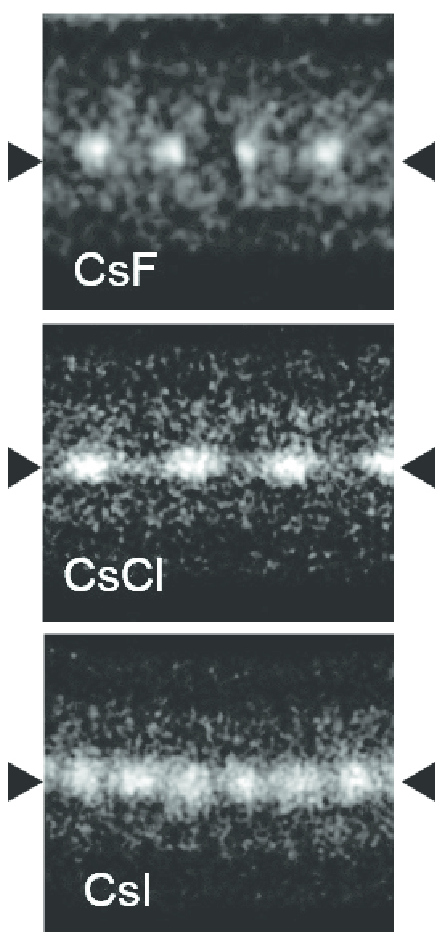|
Korea Invisible Mass Search
The Korea Invisible Mass Search (KIMS), is a South Korean experiment, led by Sun Kee Kim, searching for weakly interacting massive particles (WIMPs), one of the candidates for dark matter. The experiments use CsI( Tl) crystals at Yangyang Underground Laboratory (Y2L), in tunnels from a preexisting underground power plant. KIMS is supported by the Creative Research Initiative program of the Korea Science and Engineering Foundation. It is the first physics experiment located, and largely built, in Korea. Other research topics include detector development for a neutrinoless double beta decay search and the creation of an extreme low temperature diamond calorimeter. History The KIMS experiment was funded in 2000 to search for WIMP dark matter. To avoid the cost of creating a new tunnel for testing, the Yangyang Pumped Storage Power Plant belonging to Korea Middleland Power Co. in Yangyang, Korea was used. Construction was completed in 2003. The CsI(Tl) scintillating crystal used has ... [...More Info...] [...Related Items...] OR: [Wikipedia] [Google] [Baidu] |
Sun Kee Kim
Kim Sun-kee is a South Korean physicist. He is professor in Seoul National University and director of the Korea Invisible Mass Search. He was the first director of the Rare Isotope Science Project within the Institute for Basic Science and is a member of the Korean Academy of Science and Technology. Education * 1979−1983: BS, Korea University * 1983−1985: MS, Korea University * 1985−1988: Ph.D. Korea University Work Positions held *1988−1990: Research Associate, KEK, Japan *1990−1992: Senior Research Associate, Rutgers University *1992−1996: Assistant Professor, Seoul National University *1996−2002: Associate Professor, Seoul National University *2002−present: Professor, Seoul National University *2011−present: Director, Rare Isotope Science Project, Institute for Basic Science *1995−1995: Visiting Scientist, Fermi National Accelerator Laboratory *1999−1999: Visiting Scientist, KEK Major research activities *1985−1996: AMY experiment, TRISTAN, KEK e ... [...More Info...] [...Related Items...] OR: [Wikipedia] [Google] [Baidu] |
Weakly Interacting Massive Particles
Weakly interacting massive particles (WIMPs) are hypothetical particles that are one of the proposed candidates for dark matter. There exists no formal definition of a WIMP, but broadly, a WIMP is a new elementary particle which interacts via gravity and any other force (or forces), potentially not part of the Standard Model itself, which is as weak as or weaker than the weak nuclear force, but also non-vanishing in its strength. Many WIMP candidates are expected to have been produced thermally in the early Universe, similarly to the particles of the Standard Model according to Big Bang cosmology, and usually will constitute cold dark matter. Obtaining the correct abundance of dark matter today via thermal production requires a self-annihilation cross section of \langle \sigma v \rangle \simeq 3 \times 10^ \mathrm^ \;\mathrm^, which is roughly what is expected for a new particle in the 100 GeV mass range that interacts via the electroweak force. Experimental efforts to dete ... [...More Info...] [...Related Items...] OR: [Wikipedia] [Google] [Baidu] |
Dark Matter
Dark matter is a hypothetical form of matter thought to account for approximately 85% of the matter in the universe. Dark matter is called "dark" because it does not appear to interact with the electromagnetic field, which means it does not absorb, reflect, or emit electromagnetic radiation and is, therefore, difficult to detect. Various astrophysical observationsincluding gravitational effects which cannot be explained by currently accepted theories of gravity unless more matter is present than can be seenimply dark matter's presence. For this reason, most experts think that dark matter is abundant in the universe and has had a strong influence on its structure and evolution. The primary evidence for dark matter comes from calculations showing that many galaxies would behave quite differently if they did not contain a large amount of unseen matter. Some galaxies would not have formed at all and others would not move as they currently do. Other lines of evidence include observa ... [...More Info...] [...Related Items...] OR: [Wikipedia] [Google] [Baidu] |
Caesium Iodide
Caesium iodide or cesium iodide (chemical formula CsI) is the ionic compound of caesium and iodine. It is often used as the input phosphor of an X-ray image intensifier tube found in fluoroscopy equipment. Caesium iodide photocathodes are highly efficient at extreme ultraviolet wavelengths. Synthesis and structure Bulk caesium iodide crystals have the cubic CsCl crystal structure, but the structure type of nanometer-thin CsI films depends on the substrate material – it is CsCl for mica and NaCl for LiF, NaBr and NaCl substrates. Caesium iodide atomic chains can be grown inside double-wall carbon nanotubes. In such chains I atoms appear brighter than Cs atoms in electron micrographs despite having a smaller mass. This difference was explained by the charge difference between Cs atoms (positive), inner nanotube walls (negative) and I atoms (negative). As a result, Cs atoms are attracted to the walls and vibrate more strongly than I atoms, which are pushed toward the nanot ... [...More Info...] [...Related Items...] OR: [Wikipedia] [Google] [Baidu] |
Thallium
Thallium is a chemical element with the Symbol (chemistry), symbol Tl and atomic number 81. It is a gray post-transition metal that is not found free in nature. When isolated, thallium resembles tin, but discolors when exposed to air. Chemists William Crookes and Claude-Auguste Lamy discovered thallium independently in 1861, in residues of sulfuric acid production. Both used the newly developed method of flame spectroscopy, in which thallium produces a notable green spectral line. Thallium, from Greek language, Greek , , meaning "green shoot" or "twig", was named by Crookes. It was isolated by both Lamy and Crookes in 1862; Lamy by electrolysis, and Crookes by precipitation and melting of the resultant powder. Crookes exhibited it as a powder precipitated by zinc at the international exhibition, which opened on 1 May that year. Thallium tends to form the +3 and +1 oxidation states. The +3 state resembles that of the other elements in Boron Group, group 13 (boron, aluminium, galli ... [...More Info...] [...Related Items...] OR: [Wikipedia] [Google] [Baidu] |
Neutrino
A neutrino ( ; denoted by the Greek letter ) is a fermion (an elementary particle with spin of ) that interacts only via the weak interaction and gravity. The neutrino is so named because it is electrically neutral and because its rest mass is so small ('' -ino'') that it was long thought to be zero. The rest mass of the neutrino is much smaller than that of the other known elementary particles excluding massless particles. The weak force has a very short range, the gravitational interaction is extremely weak due to the very small mass of the neutrino, and neutrinos do not participate in the strong interaction. Thus, neutrinos typically pass through normal matter unimpeded and undetected. Weak interactions create neutrinos in one of three leptonic flavors: electron neutrinos muon neutrinos (), or tau neutrinos (), in association with the corresponding charged lepton. Although neutrinos were long believed to be massless, it is now known that there are three discrete ... [...More Info...] [...Related Items...] OR: [Wikipedia] [Google] [Baidu] |
Calorimeter
A calorimeter is an object used for calorimetry, or the process of measuring the heat of chemical reactions or physical changes as well as heat capacity. Differential scanning calorimeters, isothermal micro calorimeters, titration calorimeters and accelerated rate calorimeters are among the most common types. A simple calorimeter just consists of a thermometer attached to a metal container full of water suspended above a combustion chamber. It is one of the measurement devices used in the study of thermodynamics, chemistry, and biochemistry. To find the enthalpy change per mole of a substance A in a reaction between two substances A and B, the substances are separately added to a calorimeter and the initial and final temperatures (before the reaction has started and after it has finished) are noted. Multiplying the temperature change by the mass and specific heat capacities of the substances gives a value for the energy given off or absorbed during the reaction. Dividing t ... [...More Info...] [...Related Items...] OR: [Wikipedia] [Google] [Baidu] |
Yangyang
Yangyang County (''Yangyang-gun'') is in Gangwon Province, South Korea. The county is located in the northeast of the country in Gangwon-do. Its population is about 31,000 (2004). The Yangyang area is well known for its pine mushrooms (''song-i''), its fish—particularly salmon—and its sunrises. Overview In 2002, Yangyang opened its own airport, serving Gangneung to the south and Sokcho to the north. It was intended for the many tourists attracted by the Seorak-san national park. But the airport was closed in 2009 due to a lack of passengers. The county is proud to unite the five major religions of Korea: Confucianism, Buddhism, Shamanism, Protestantism and Roman Catholicism. There are sites for all these faiths in Yangyang. ''Seonghwangsa'' is a shamanistic altar which was traditionally used for sacrificial rites. ''Yangyang Hyanggyo'' is a Confucian school built in 1340. Today the school mainly serves as a shrine, but classes are still held there. In 1921, ''Yan ... [...More Info...] [...Related Items...] OR: [Wikipedia] [Google] [Baidu] |
Scintillator
A scintillator is a material that exhibits scintillation, the property of luminescence, when excited by ionizing radiation. Luminescent materials, when struck by an incoming particle, absorb its energy and scintillate (i.e. re-emit the absorbed energy in the form of light). Sometimes, the excited state is metastable, so the relaxation back down from the excited state to lower states is delayed (necessitating anywhere from a few nanoseconds to hours depending on the material). The process then corresponds to one of two phenomena: delayed fluorescence or phosphorescence. The correspondence depends on the type of transition and hence the wavelength of the emitted optical photon. Principle of operation A scintillation detector or scintillation counter is obtained when a scintillator is coupled to an electronic light sensor such as a photomultiplier tube (PMT), photodiode, or silicon photomultiplier. PMTs absorb the light emitted by the scintillator and re-emit it in the form of ele ... [...More Info...] [...Related Items...] OR: [Wikipedia] [Google] [Baidu] |
DAMA/LIBRA
The DAMA/LIBRA experiment is a particle detector experiment designed to detect dark matter using the direct detection approach, by using a matrix of NaI(Tl) scintillation detectors to detect dark matter particles in the galactic halo. The experiment aims to find an annual modulation of the number of detection events, caused by the variation of the velocity of the detector relative to the dark matter halo as the Earth orbits the Sun. It is located underground at the Laboratori Nazionali del Gran Sasso in Italy. It is a follow-on to the DAMA/NaI experiment which observed an annual modulation signature over 7 annual cycles (1995-2002). While DAMA/LIBRA has published exciting results, the validity of those results has been widely disputed; they have not made their data or practices publicly available, and their methods of background noise reduction is such that it may actually account for a large part of their proposed signal annual modulation. Two other studies, attempting to ... [...More Info...] [...Related Items...] OR: [Wikipedia] [Google] [Baidu] |
Nature (journal)
''Nature'' is a British weekly scientific journal founded and based in London, England. As a multidisciplinary publication, ''Nature'' features peer-reviewed research from a variety of academic disciplines, mainly in science and technology. It has core editorial offices across the United States, continental Europe, and Asia under the international scientific publishing company Springer Nature. ''Nature'' was one of the world's most cited scientific journals by the Science Edition of the 2019 ''Journal Citation Reports'' (with an ascribed impact factor of 42.778), making it one of the world's most-read and most prestigious academic journals. , it claimed an online readership of about three million unique readers per month. Founded in autumn 1869, ''Nature'' was first circulated by Norman Lockyer and Alexander Macmillan as a public forum for scientific innovations. The mid-20th century facilitated an editorial expansion for the journal; ''Nature'' redoubled its efforts in exp ... [...More Info...] [...Related Items...] OR: [Wikipedia] [Google] [Baidu] |







